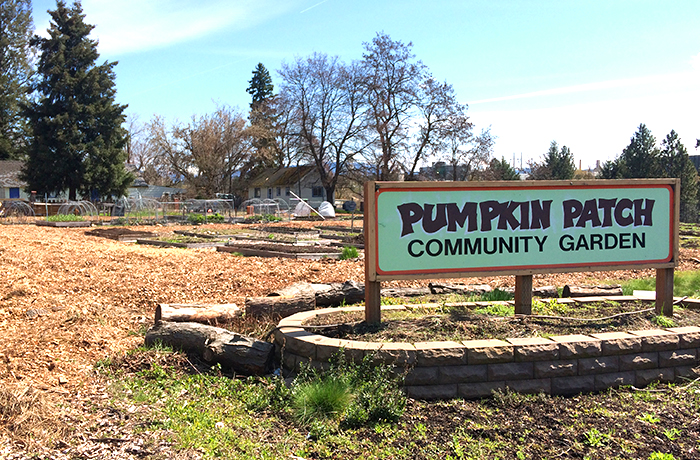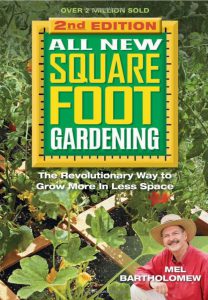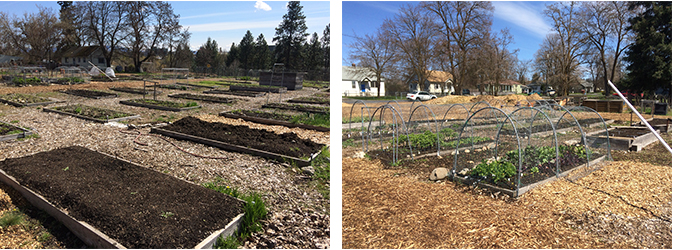Community gardening: a delicious pursuit to feed the hungry and the soul
Posted on April 25, 2017 at 6:00 am
By Erin Dodge
I met with Teresa Sadler of Pumpkin Patch Community Garden to talk about the garden and learn her take on gardening, especially as a community. Originally a pumpkin patch and then a parking lot and staging site for the construction company that built the bridge over the river, the community garden was started as an attempt to reclaim the land, which was packed down to hard dirt, and put it to good use. They’ve brought in a lot of compost over the years to help.
The climate right by the river is nice, Teresa says, and gets quite a bit of sun, so the ground stays pretty warm. She can grow produce there that she can’t at home, like kale and lots of lettuces.
For folks new to the concept of a community garden, I asked Teresa to explain how a community garden works and what the benefits and limitations of joining one are.
The community garden is for people whose property is too small or who live in an apartment, or like her, have property that is primarily in the shade, she said. It shows people that you can grow a lot of food in a small space. It’s also for people who enjoy gardening with others or who like helping and teaching others about gardening.
For those who are intimidated by taking on a 4 ft. by 10 ft. garden plot, Teresa suggests taking one on with a friend or consider sharing the bed and the work between a couple of families. Gardening can be great exercise and a great way to bond.
For beginners and those with kids, Teresa recommends reading the quintessential book for plot gardening, All New Square Foot Gardening by Mel Bartholomew.
Here are a few more benefits, and some limitations, of joining the community garden:
Nutrition
Freshly picked produce has more nutrients, which is a major benefit. Produce loses nutrients after being picked, due to respiration and enzymes. And decreases dramatically if it has been in transport and sitting on a shelf for a long time. This also leads to flavor…
Flavor
Freshly picked veggies and fruit that are ripe have amazing flavor. Those nutrients are at play. As produce loses nutrients, it loses flavor. Anyone who has done some berry picking has experienced that sweet zing of freshness. Teresa shared, “that’s why microgreens are really healthy. You have a little tray where they are growing, and then you eat them. Pea plants are also delicious and taste just like peas. Most people don’t know you can eat them as microgreens.”
Teresa has noticed a benefit for families too: after working in a garden, kids will suddenly start eating the fruit and veggies they grow. She attributes this in part to the amazing flavor and in part to the sense of pride kids take in growing the food. Teresa’s granddaughter used to proclaim that she didn’t like vegetables. Then she tried a few straight from the garden. Now she eats lots of veggies.
Once a year, they have a brunch at the community garden to show members how to cook food from the garden and enjoy the flavors from their efforts.
Charitable giving
At the Patch, Teresa and her fellow gardeners grow about half of the garden for the Spokane Valley Partners Food Bank. The organic produce can really help provide nutritious food for those served by the food bank. She encourages everyone who takes on a garden plot to help with the plants grown for the food bank.
Some limitations
For some people, a limitation of a community garden is that it is not at their home. You have to commit to come to the garden. For some this is part of the attraction—to get outside, even if it is only a short trip from home to the garden. For Pumpkin Patch Community Garden in particular, situated next to Argonne Road, which is an arterial route for many people to and from the valley and the north side, some community members don’t live nearby but work nearby or travel by regularly, so the garden is a convenient stop on their daily commute.
Teresa warns that there are limitations on what can be grown in a plot at the Patch—no invasive species, for example. However, there is enough land that she can usually find a spot for those that want to grow plants that can’t be in the plots. Herbs are a good example: they grow quite a few varieties at the garden, away from the plots, that are available for harvest by community members. The garden also has rules for pesticides, fertilizers, watering, plot maintenance, and so on.
“Don’t be discouraged by nature,” she warns. “I recall a sign that read, ‘Plant one for the bugs, plant one for the birds, plant one for the bunnies, and plant one for yourself.’ Plus if something dies, you can plant it again.” Always good to remember when gardening.
Community partners
Teresa shares that they’ve been very fortunate in their partnerships. Inland Empire Paper Company owns the land, providing it to the community garden for use, and has provided compost from BaRR-TeCH. Millwood Boy Scout Troop 0430 built the composting bins for the garden. Other community organizations that help to keep the land usable for gardening include River City Leadership Academy, Hutton Settlement, West Valley City School, the St. Paschal Parish Boy Scout Troop, and youth from Summit Spokane.
There’s always lots to do at the garden, and for anyone looking for a service project or just wanting to help out the community, here is a list of opportunities to help the Pumpkin Patch Community Garden. Teresa’s biggest desire is to get an information kiosk, like you see along the trailheads, to keep all community members connected and up to date with information.
Joining the community garden
2017 is season eight for Pumpkin Patch Community Garden. When we spoke, Teresa shared that they still have around 16 plots available out of about 60 total. The community garden is a nonprofit through Millwood Community Presbyterian Church, who accepts the signed agreements and annual $20 fee.
As an added incentive, Teresa will give new members two plant starts from a selection of tomatoes, peppers, and eggplants (while supplies last). She can help answer gardening questions and one community member is a master gardener.
Contact Teresa to join the Pumpkin Patch Community Garden. To find other community gardens around the Spokane area, visit the Spokane Community Gardens website. Now is the perfect time to get started!
Classes and resources
The WSU Master Gardener Plant Clinic and Resource Center holds classes and welcomes gardeners to call or visit to get help with plant care and pest management issues. The Resource Center has books, fact sheets, and publications on many home gardening and horticulture topics.
The Planting Dates Calculator for Spokane, Washington, from The Old Farmer’s Almanac, covers the 30 most popular vegetables, herbs, and fruit and uses historical data from local weather stations to calculate the best range of planting dates. You can even set up reminders by email and print the planting calendar. Also from The Old Farmer’s Almanac website, the Companion Planting Chart provides a friend and foe plant list for the 10 most common vegetables.
Upcoming fairs and plant sales
Garden Fair and Plant Sale
Master Gardener Foundation of Spokane County (map)
Saturday, April 29, 9am–2pm
Plant Sale 2017
Associated Garden Clubs of Spokane
Parking lot east of Gaiser Conservatory, Manito Park (map)
Saturday, April 29, 9am–5pm and Sunday, April 30, 10am–2pm
Garden Expo 2017
Spokane Community College (map)
Saturday, May 13, 9am–5pm
Spring Plant Sale
The Friends of Manito
Parking lot east of Gaiser Conservatory, Manito Park (map)
Saturday, June 3, 8am–3pm

Teresa Sadler was raised in Central Illinois and started gardening with her father when she was young. She joined the military out of high school and moved from Maryland to Texas, to Florida, to Mississippi, to Oklahoma, and then to San Diego. She came to Spokane in 1995 and became the coordinator for the Pumpkin Patch Community Garden in 2010. She has gardened a loop around the United States and enjoys Spokane the best of all!
Tags: adults, community, community garden, DIY, family, food, fruit, gardening, hobbies, kids, parents, plants, plot gardening, produce, urban farming, vegetables, veggies




